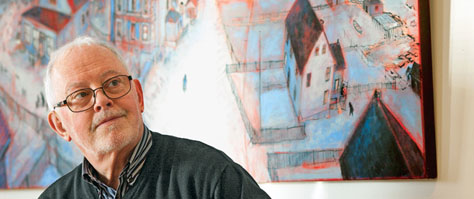
“You can be doing important work, but the curatorial and academic world can be caught up with what’s new and exciting so things become ignored.”
—David Blackwood
David Blackwood Finally Gets His Moment in the Sun
Beloved of audiences and, secretly, of collectors, Blackwood’s recognition is 40 years in the making.
—
In 1964, months after David Blackwood graduated from Toronto’s Ontario College of Art, he had a moment every artist dreams of. His etching The Search Party was selected—over the work of his teachers—by the New York-based art guru and guest curator William S. Lieberman to be part of an exhibition of prints and drawings at the National Gallery of Canada. It was a star-making moment, and one that should have sealed his future as an artist. “But after that, forget it,” whispers Blackwood, 69, explaining how his show Black Ice, opening this week at the Art Gallery of Ontario before it travels to St. John’s in 2012, is the first time in his career a major Canadian public institution has comprehensively showcased his art.
Understated and reserved, Blackwood holds no grudge over the fact that he was also shut out by the AGO, back in the 1980s when the gallery’s contemporary committee rejected a donation of his art. “You can be doing important work,” he says with a shrug, “but the curatorial and academic world can be caught up with what’s new and exciting so things become ignored.” Paradoxically, while being overlooked by the tastemakers, Blackwood—a recipient of the Order of Canada for his potent visual encapsulation of Newfoundland life—passionately connected with audiences, even the ones who knew his work was out of fashion. “Every major collector bought a David Blackwood,” says Katharine Lochnan, senior curator at the AGO and the curatorial visionary behind Black Ice, “but usually placed it behind the bedroom door.” While Blackwood works with a variety of media including paint and, more recently, sculpture, he is most famous for his richly layered prints of sublime landscapes, like his masterpiece Fire Down on the Labrador (1980). An image of a fishing party that escapes, in the nick of time, from its ship set ablaze, the work is a surreal portrait of the excruciating tension between despair and hope. The crew cannot see what Blackwood shares with his viewers: a mammoth whale lurking beneath the water’s surface, ready—or not—to plunge the tiny vessel into the icy Atlantic. Featuring over 70 of the artist’s best prints and personal artifacts alongside historical photographs, Black Ice masterfully highlights his phenomenal narrative powers while forcing attention to the origins of his visions, in the traditions and tragedies of Newfoundland. The exhibition also includes Blackwood’s printmaking equipment and offers a step-by-step exploration of his extraordinary skill at transferring ink from an incised metal plate onto sheets of paper, revealing a singular online casino and dazzling technical virtuoso. Blackwood first embraced printmaking while at the Ontario College of Art. Ironically, this very medium worked against him. In the ’70s and ’80s, when artists, including the Group of Seven’s A.J. Casson, began signing reproductions of paintings—essentially posters—and calling them “prints,” marketplace confusion arose around the status and authenticity of Blackwood’s work. At the same time, explains Lochnan, art-world institutions deemed anything steeped in traditional lore “as of a lesser significance and seriousness than abstraction.” Things began to change in the early ’90s. Then, Annie Proulx was inspired to set her Pulitzer-Prize-winning novel The Shipping News in Newfoundland after receiving a book of Blackwood’s prints. The work she chose for the cover, Hauling Job Sturge’s House (1979), became not only one of the most internationally circulated works of Canadian art, it helped turn Newfoundland into one of the hottest places on the planet. At the AGO, a new chief curator, Matthew Teitelbaum, arrived in 1993 with an interest in Blackwood, as international curatorial attention returned to storytelling. Moreover, it became increasingly hard to maintain a professional snobbery toward printmaking with the emergence of new experimental media. But most of all, as Lochnan points out, Blackwood is in the spotlight because he has become historic—”classifiable today more as a Canadian icon than a contemporary artist.”